Milwaukee HP EVS 5616-24 Handleiding
Milwaukee
Niet gecategoriseerd
HP EVS 5616-24
Bekijk gratis de handleiding van Milwaukee HP EVS 5616-24 (36 pagina’s), behorend tot de categorie Niet gecategoriseerd. Deze gids werd als nuttig beoordeeld door 28 mensen en kreeg gemiddeld 4.6 sterren uit 14.5 reviews. Heb je een vraag over Milwaukee HP EVS 5616-24 of wil je andere gebruikers van dit product iets vragen? Stel een vraag
Pagina 1/36

To reduce The risk of injury, user musT read and undersTand operaTor's
manual.
afin de réduire le risque de blessures, l'uTilisaTeur doiT lire eT bien
comprendre le manuel de l'uTilisaTeur.
para reducir el riesgo de lesiones, el usuario debe leer y enTender el
manual del operador.
OPERATOR'S MANUAL
MANUEL de L'UTILISATEUR
MANUAL del OPERADOR
Cat. No.
No de cat.
5615-20 5616-20
5619-20 5625-20
48-10-5600
HEAVY-DUTY ROUTERS
TOUPIES EXTRA-ROBUSTES
BURILADORAS PARA SERVICIO PESADO

2
GENERAL POWER TOOL SAFETY WARNINGS
WARNING READ ALL SAFETY WARNINGS AND ALL INSTRUCTIONS. Failure to
follow the warnings and instructions may result in electric shock, re and/or serious injury.
Save
all warnings and instructions for future reference. The term “power tool” in the warn-
ings refers to your mains-operated (corded) power tool or battery-operated (cordless) power tool.
PERSONAL SAFETY
WORK AREA SAFETY
ELECTRICAL SAFETY
• Keep work area clean and well lit. Cluttered or
dark areas invite accidents.
• Do not operate power tools in explosive atmos-
pheres, such as in the presence of ammable
liquids, gases or dust. Power tools create sparks
which may ignite the dust or fumes.
• Keep children and bystanders away while
operating a power tool. Distractions can cause
you to lose control.
• Power tool plugs must match the outlet. Never
modify the plug in any way. Do not use any
adapter plugs with earthed (grounded) power
tools. Unmodied plugs and matching outlets will
reduce risk of electric shock.
• Avoid body contact with earthed or grounded
surfaces such as pipes, radiators, ranges and
refrigerators. There is an increased risk of electric
shock if your body is earthed or grounded.
• Do not expose power tools to rain or wet condi-
tions. Water entering a power tool will increase
the risk of electric shock.
• Do not abuse the cord. Never use the cord for
carrying, pulling or unplugging the power tool.
Keep cord away from heat, oil, sharp edges
or moving parts. Damaged or entangled cords
increase the risk of electric shock.
• When operating a power tool outdoors, use an
extension cord suitable for outdoor use. Use
of a cord suitable for outdoor use reduces the risk
of electric shock.
• If operating a power tool in a damp location is
unavoidable, use a ground fault circuit inter-
rupter (GFCI) protected supply. Use of an GFCI
reduces the risk of electric shock.
• Remove any adjusting key or wrench before
turning the power tool on. A wrench or a key left
attached to a rotating part of the power tool may
result in personal injury.
• Do not overreach. Keep proper footing and
balance at all times. This enables better control
of the power tool in unexpected situations.
• Dress properly. Do not wear loose clothing or
jewellery. Keep your hair, clothing and gloves
away from moving parts. Loose clothes, jewel-
lery or long hair can be caught in moving parts.
• If devices are provided for the connection of
dust extraction and collection facilities, ensure
these are connected and properly used. Use of
dust collection can reduce dust-related hazards.
POWER TOOL USE AND CARE
• Do not force the power tool. Use the correct
power tool for your application. The correct
power tool will do the job better and safer at the
rate for which it was designed.
• Do not use the power tool if the switch does not
turn it on and off. Any power tool that cannot be
controlled with the switch is dangerous and must
be repaired.
• Disconnect the plug from the power source
and/or the battery pack from the power tool
before making any adjustments, changing
accessories, or storing power tools. Such pre-
ventive safety measures reduce the risk of starting
the power tool accidentally.
• Store idle power tools out of the reach of chil-
dren and do not allow persons unfamiliar with
the power tool or these instructions to operate
the power tool. Power tools are dangerous in the
hands of untrained users.
• Maintain power tools. Check for misalignment
or binding of moving parts, breakage of parts
and any other condition that may affect the
power tool’s operation. If damaged, have the
power tool repaired before use. Many accidents
are caused by poorly maintained power tools.
• Keep cutting tools sharp and clean. Properly
maintained cutting tools with sharp cutting edges
are less likely to bind and are easier to control.
• Use the power tool, accessories and tool bits
etc. in accordance with these instructions, tak-
ing into account the working conditions and
the work to be performed. Use of the power tool
for operations different from those intended could
result in a hazardous situation.
• Stay alert, watch what you are doing and use
common sense when operating a power tool.
Do not use a power tool while you are tired or
under the inuence of drugs, alcohol or medi-
cation. A moment of inattention while operating
power tools may result in serious personal injury.
• Use personal protective equipment. Always
wear eye protection. Protective equipment such
as dust mask, non-skid safety shoes, hard hat, or
hearing protection used for appropriate conditions
will reduce personal injuries.
• Prevent unintentional starting. Ensure the
switch is in the off-position before connecting
to power source and/or battery pack, picking
up or carrying the tool. Carrying power tools with
your nger on the switch or energising power tools
that have the switch on invites accidents.
SERVICE
• Have your power tool serviced by a qualied
repair person using only identical replacement
parts. This will ensure that the safety of the power
tool is maintained.

3
specific safeTy rules
specificaTions
Cat. No.
Volts
AC Amps
No Load
RPM
Max
HP
5615-20*
Bodygrip®
120 24,000 1-3/411
5616-20*
Bodygrip®
120 13 10,000-24,000 2-1/4
5619-20
D-Handle
120 24,000 1-3/411
5625-20
Production
120 15 10,000-22,000 3-1/2
symbology
• Hold power tool by insulated gripping surfac-
es, because the cutter may contact its own
cord. Cutting a "live" wire may make exposed
metal parts of the power tool "live" and shock
the operator.
• Use clamps or another practical way to se-
cure and support the workpiece to a stable
platform. Holding the work by your hand or
against the body leaves it unstable and may lead
to loss of control.
• Always wear safety goggles and dust mask.
Use only in a well ventilated area. Using per-
sonal safety devices and in a safe environment
reduce the risk for injury.
• Some woods contain preservatives that can be
toxic. Take extra care to prevent inhalation and
skin contact when working with these materials.
Request, and follow, any safety information avail-
able from your material supplier.
• Always make sure the workpiece is free from
nails, screws and other foreign objects. Keep
the working edge away from the clamping
surface. Cutting these objects can cause loss
of control of the tool and damage to the bit.
• Never hold the workpiece in one hand and
the tool in the other hand when using the
tool. Never place hands near or below cutting
surface. Clamping the material and guiding the
tool with both hands is safer.
• Never use dull or damaged bits. Sharp bits
must be handled with care. Damaged bits can
break during use. Dull bits require more force to
push the tool, which could cause the bit to break.
Damaged bits can throw carbide pieces and burn
the workpiece.
• After changing the bit or making any adjust-
ments, make sure the collet nut and any
other adjustment devices are securely tight-
ened. Loose adjustment devices can unexpect-
edly shift, causing loss of control. Loose rotat-
ing components will be violently thrown. Watch
for vibration or wobbling that could indicate an
improperly installed bit.
• Maintain rm grip on router when starting
motor to resist starting torque.
• Always keep the power supply cord away from
moving parts on the tool. Keep the cord away
from the direction of the cut.
• Never start the tool when the bit is in contact
with the material. The bit cutting edge may grab
the material causing loss of control of the tool.
• Never lay the tool down until the bit has come
to a complete stop. The spinning bit can grab
the surface and pull the tool out of your control.
• Never touch the bit during or immediately after
use. After use the bit may be hot enough to burn
bare skin.
• Never clamp the workpiece to a hard surface,
such as concrete or stone. Contact with the bit
could cause the tool to jump and loss of control.
• Only operate the routers when held. Do not
clamp or secure the router to a surface and hold
the workpiece by hand.
• Never use bits larger than the smallest of the
openings in the base, sub-base, or dust collection
port.
• Do not loosen or remove the
plunge base caps. Internal
springs are under pressure.
If loosened or removed, the
plunge base caps and internal
springs will become projectiles,
which could cause injury.
• Maintain labels and name-
plates. These carry important
information. If unreadable or
missing, contact a MILWAUKEE
service facility for a free replacement.
• WARNING: Some dust created by power sanding,
sawing, grinding, drilling, and other construction
activities contains chemicals known to cause
cancer, birth defects or other reproductive harm.
Some examples of these chemicals are:
• lead from lead-based paint
• crystalline silica from bricks and cement and
other masonry products, and
• arsenic and chromium from chemically-treated
lumber.
Your risk from these exposures varies, depending
on how often you do this type of work. To reduce
your exposure to these chemicals: work in a well
ventilated area, and work with approved safety
equipment, such as those dust masks that are
specifically designed to filter out microscopic
particles.
* Also compatible with plunge base 48-10-5600,
available separately and in kits.
Plunge Base Caps
Double Insulated
Volts
Alternating Current
Amps
No Load Revolutions per
Minute (RPM)
Underwriters Laboratories, Inc.
United States and Canada
CUS
Product specificaties
| Merk: | Milwaukee |
| Categorie: | Niet gecategoriseerd |
| Model: | HP EVS 5616-24 |
Heb je hulp nodig?
Als je hulp nodig hebt met Milwaukee HP EVS 5616-24 stel dan hieronder een vraag en andere gebruikers zullen je antwoorden
Handleiding Niet gecategoriseerd Milwaukee

15 September 2025
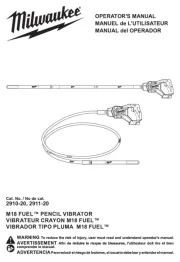
1 September 2025
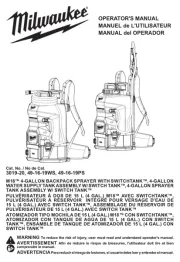
1 September 2025
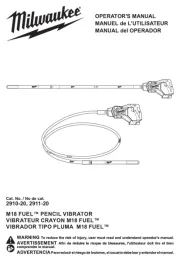
1 September 2025
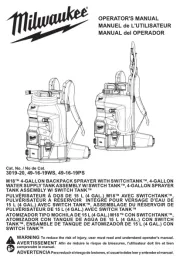
1 September 2025
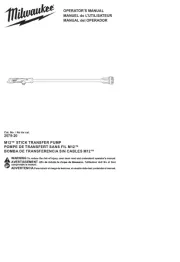
19 Augustus 2025
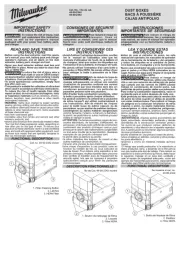
19 Augustus 2025
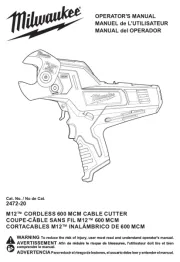
19 Augustus 2025

18 Augustus 2025

18 Augustus 2025
Handleiding Niet gecategoriseerd
- Ganz
- Arebos
- Daitsu
- ChyTV
- TROND
- KMA Machines
- Crunch
- Oversteel
- Hoymiles
- Logic
- Neptun
- On-Q
- STRICH
- Garden Feelings
- Elight
Nieuwste handleidingen voor Niet gecategoriseerd
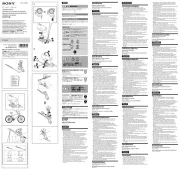
16 September 2025
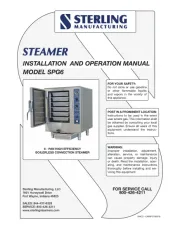
16 September 2025
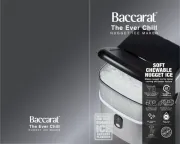
16 September 2025
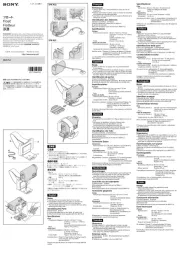
16 September 2025
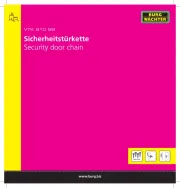
16 September 2025
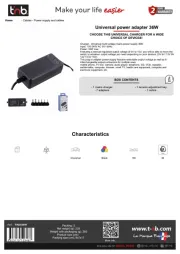
16 September 2025
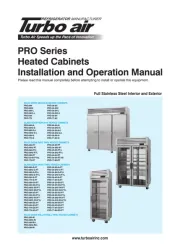
16 September 2025
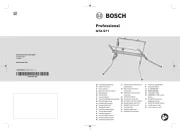
16 September 2025
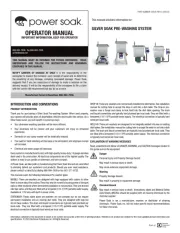
16 September 2025
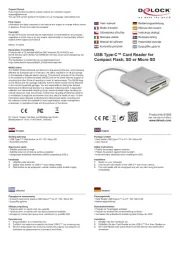
16 September 2025